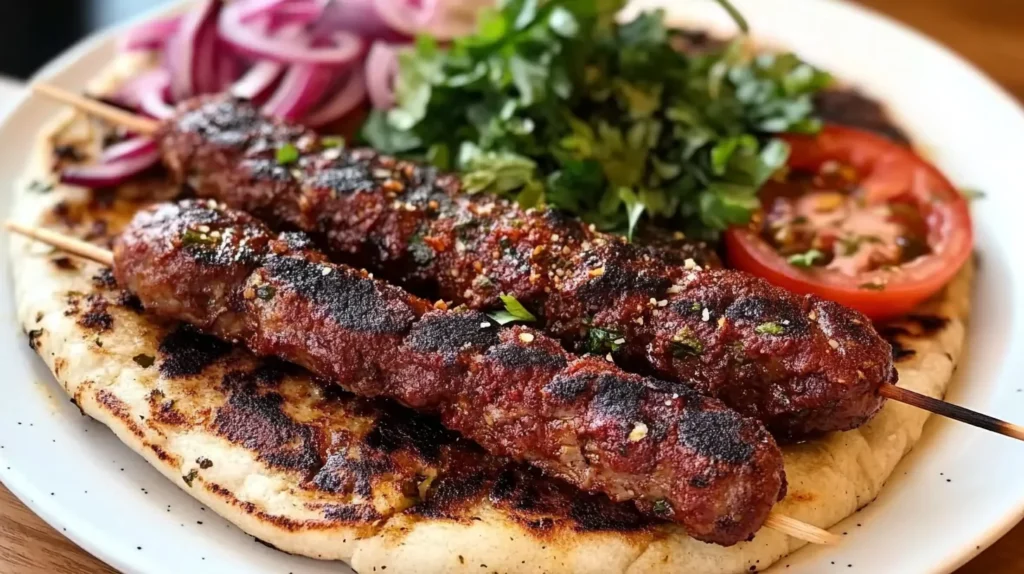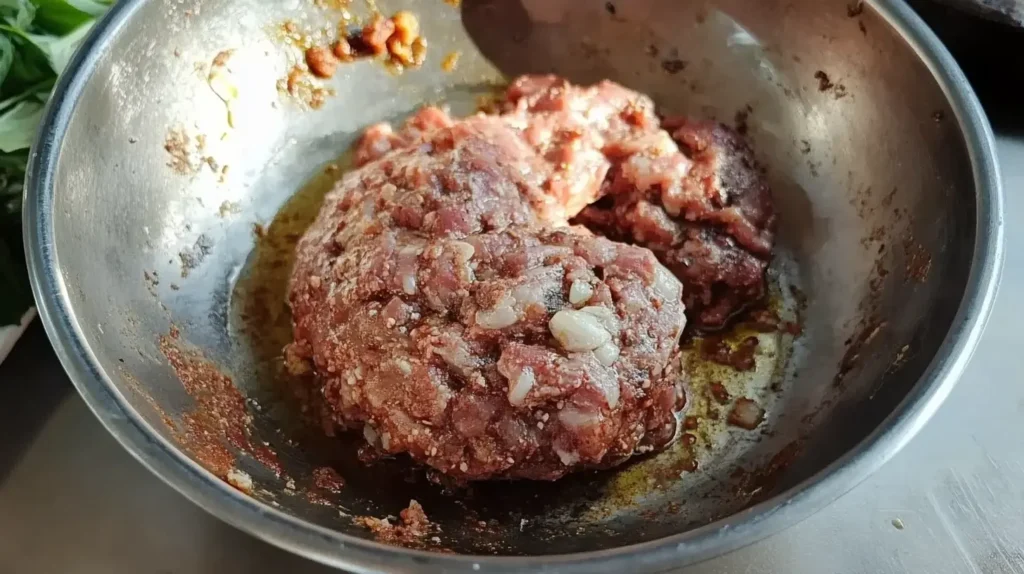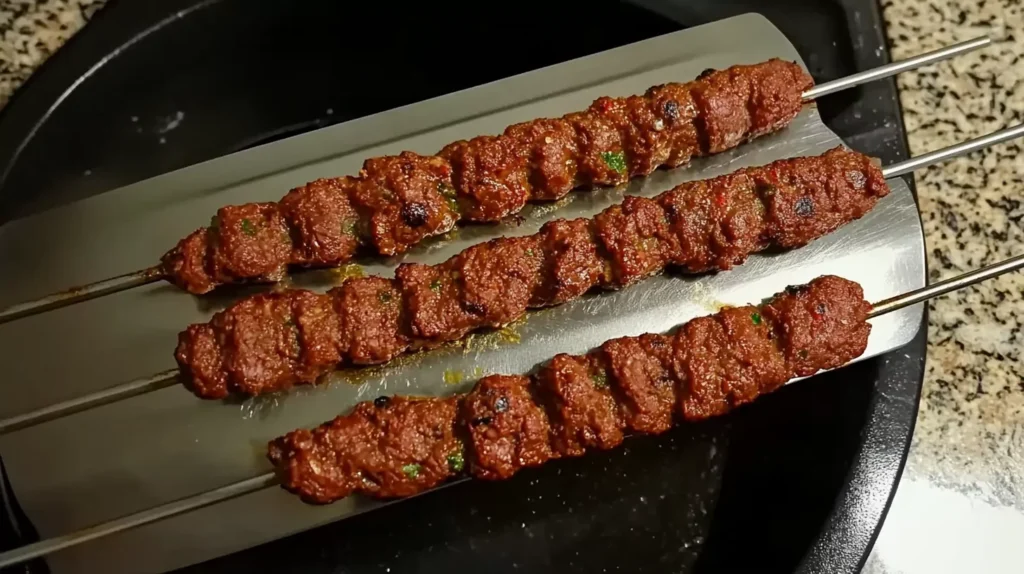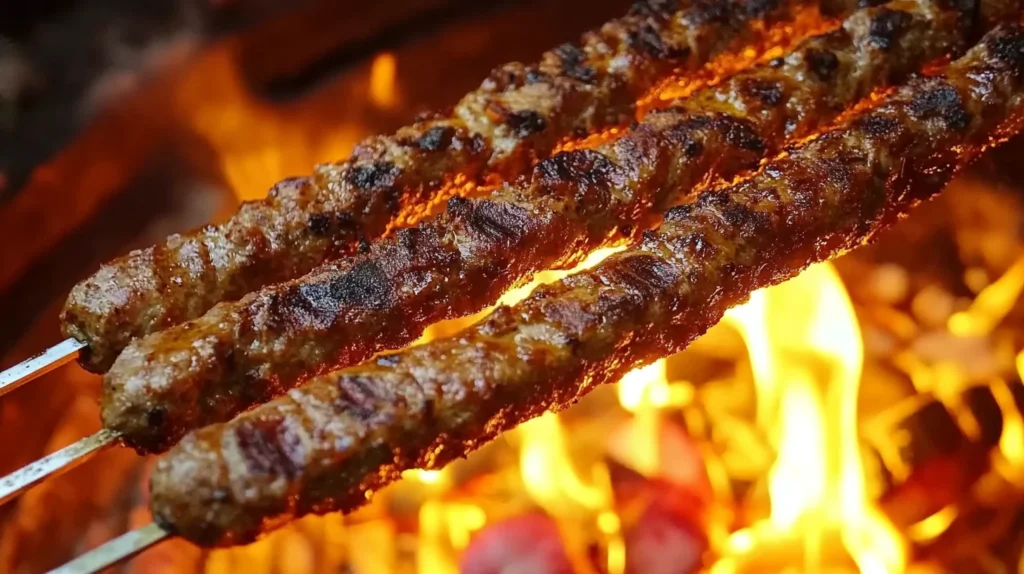
Overview of Adana Kebab Recipe
Introduction to Adana Kebab
If you’ve ever experienced the vibrant food scene in Turkey, then you know that Adana Kebab is a star player on the culinary stage. Originating from the city of Adana in southern Turkey, this dish captures the essence of Turkish grilling traditions. The Adana Kebab is crafted by mincing meat—typically lamb—along with a medley of spices that create a flavor explosion with each bite.
In many ways, this dish tells a story of its roots. The preparation is straightforward yet requires skill and finesse, and it serves as a great symbol of hospitality in Turkish culture. During my travels, sharing a plate of Adana Kebab with friends and family over a warm meal was always a joyful experience. The smoke wafting from the grill, the sizzling sound as the meat cooks, and the mouth-watering aroma encapsulate the charm of gathering around food.
Adana Kebab is truly a celebration of flavors. Every bite reminds me of the warmth of Turkish hospitality. I can’t wait to try this at home and bring a piece of Turkey to my table! Sarah Thompson, Food Enthusiast.
Significance of Adana Kebab in Turkish Cuisine
Adana Kebab is not just a dish; it’s an emblem of cultural significance that resonates deeply within Turkish cuisine. Here are a few reasons why it holds such a revered position:
- Culinary Heritage: This dish is part of Turkey’s diverse kebab family, showcasing regional flavors and traditional cooking methods. Each bite is a testament to culinary techniques passed down through generations.
- Symbol of Togetherness: Traditionally, Adana Kebab is enjoyed during gatherings, at family dinners, or even special occasions. The communal nature of sharing kebabs encourages connection and celebration among those at the table.
- Rich Ingredients: The kebab is famous not only for its taste but also for its quality ingredients—freshly minced high-quality meat mixed with fragrant spices such as red pepper flakes, cumin, and garlic. These elements are vital for achieving the dish’s signature taste and texture.
- Culinary Versatility: While the classic Adana Kebab features lamb, variations exist that include chicken, beef, or even vegetarian options. This versatility allows it to cater to different palates and dietary preferences, making it a popular choice in many settings.
In my experience, a plate of Adana Kebab, particularly when prepared with authentic ingredients and served with the right accompaniments, can transport you straight to the heart of Turkey. Whether it’s a bustling restaurant or a backyard BBQ, this dish always brings a taste of tradition and joy to the table.
Incorporating Adana Kebab into your meal rotation is not merely about enjoying a delicious dish; it’s also about engaging with the rich tapestry of Turkish culture and its enduring appreciation for food.
Ingredients for Adana Kebab
List of Main Ingredients
Now that we’ve explored the rich cultural significance of Adana Kebab, let’s dive into the ingredients that bring this dish to life. The beauty of Adana Kebab lies in its simplicity—using just a handful of high-quality components can yield incredible flavors.
Here’s a table detailing the main ingredients you’ll need:
| Ingredient | Quantity |
|---|---|
| Ground lamb | 1 kg (2.2 lbs) |
| Fatty lamb (or lamb fat) | 200-250 grams (7-9 oz) |
| Onion | 1 medium-sized, finely grated |
| Garlic | 3-4 cloves, minced |
| Red pepper flakes | 1-2 tablespoons |
| Cumin | 1 teaspoon |
| Salt | To taste |
| Black pepper | 1 teaspoon |
| Fresh parsley | For garnish (optional) |
| Kebabs skewers | Metal or soaked bamboo skewers |
To create that authentic Adana Kebab flavor profile, I always recommend using a combination of lean and fatty lamb. The fat adds moisture and richness, ensuring that the kebabs stay juicy as they grill. My family uses fresh garlic and onion for a punch of flavor—trust me, the aroma that fills the kitchen is heavenly!
I love the simplicity of the ingredients here, yet it’s packed with so much flavor. The balance between spices and fresh herbs makes Adana Kebab the perfect dish to serve for a summer BBQ with friends. Mark Sullivan, Grill Master.
Optional Ingredients for Variation
While the classic Adana Kebab recipe is fantastic on its own, there are plenty of ways to tweak the ingredients to suit your taste preferences or dietary needs. Here are some optional ingredients you can consider:
- Different Meats: If lamb isn’t your favorite, you can try using:
- Ground beef
- Ground chicken
- Ground turkey
- Herbs and Spices: Experiment with:
- Coriander for a fresh note
- Mint for a refreshing twist
- Paprika for subtle smokiness
- Vegetable Add-ins: To add a unique texture or flavor, consider mixing in:
- Finely chopped bell peppers
- Grated zucchini (make sure to remove excess moisture)
- Gluten-Free Binders: If you want to bind the mixture without bread or breadcrumbs:
- Use beaten egg
- Add cooked rice or quinoa
As someone who loves to entertain, I often find myself customizing the recipes based on my guests’ preferences. Offering a vegetarian option made with chickpeas or lentils has become a hit at my dinner parties.
Feel free to get creative! Cooking is, at its core, about sharing flavors and experiences. By mixing up these ingredients, you’re not just preparing a meal; you’re crafting your unique take on the beloved Adana Kebab. It brings a delightful sense of personalization and innovation while still celebrating traditional flavors.
Preparation of Adana Kebab

Preparing the Meat Mixture
Now that we have our ingredients lined up, the fun truly begins with preparing the meat mixture for Adana Kebab! This step is crucial because it sets the foundation for the kebabs’ flavor and texture.
To start, here’s how I like to prepare the meat mixture:
- Chop and Grind: The first step is to cut the lamb and any fatty lamb into small chunks. If you prefer, you can ask your butcher to grind it for you. However, I find that grinding it at home gives more control over the texture. You want a slightly coarse mixture for the right bite.
- Combine Ingredients: In a large mixing bowl, add the ground lamb, grated onion, minced garlic, red pepper flakes, cumin, salt, and black pepper. Don’t forget the fattier lamb if you have it!
- Mix Thoroughly: Using your hands, mix the ingredients thoroughly. It’s important to knead the mixture for about 5-10 minutes to ensure that everything binds properly, allowing the flavors to meld together. Getting your hands dirty is part of the fun! I love getting my kids involved in this process because it builds anticipation for the meal.
- Resting Time: After mixing, cover the bowl with plastic wrap and let it rest in the refrigerator for about 30 minutes. This waiting period allows the flavors to develop beautifully.
Assembling Kebab Skewers
Once your delicious meat mixture is ready, the next step is to assemble the kebab skewers. This is where your creativity can truly shine, and it’s so easy! Here’s how to do it:

- Prepare the Skewers: If you’re using wooden skewers, it’s best to soak them in water for about 30 minutes beforehand. This prevents them from burning on the grill. Metal skewers can be used as is.
- Shape the Meat: Take a handful of the meat mixture—about the size of a lemon—and mold it onto the skewer. I usually aim for about 1 inch thickness, evenly distributed along the skewer. This helps ensure that the kebabs cook uniformly.
- Press Firmly: It’s essential to press the meat firmly around the skewer to prevent it from falling apart while grilling. Remember, the better you shape it, the more satisfying the kebab experience!
- Chill Again: Once you’ve assembled the skewers (this recipe usually yields about 6-8 kebabs), pop them back in the fridge for about 15-20 minutes. This chilling helps the meat set on the skewers, making it easier to handle.
As I put my skewers together, I can’t help but fondly recall nights spent grilling with friends. The excitement of watching those kebabs cook and the promise of a delicious meal always adds to the joy of gathering for a special occasion.
With the meat mixture prepared and skewers assembled, you’re now ready to move on to the cooking techniques for our delectable Adana Kebab!
Cooking Techniques for Adana Kebab
Grilling Method

Now that we’ve prepared our delicious Adana Kebab skewers, it’s time to talk about the cooking techniques that truly bring these kebabs to life. For me, grilling is the quintessential method to achieve that perfectly charred and smoky flavor that defines Adana Kebab.
Here’s how to grill your kebabs to perfection:
- Preheat the Grill: Whether you’re using a charcoal grill or a gas grill, ensure it’s hot and preheated to medium-high heat. If using charcoal, let the coals turn white before grilling.
- Oil the Grill Grate: Lightly oil the grill grate with a paper towel soaked in oil to prevent sticking. I find this step crucial, especially when grilling juicy kebabs.
- Arrange the Skewers: Place your kebab skewers onto the grill at a slight angle to get even grill marks. Make sure to leave some space between each skewer for even cooking.
- Cook and Rotate: Grill the kebabs for about 10-12 minutes, turning every few minutes. This ensures they cook evenly on all sides. What I love about grilling is that moment when you hear that glorious sizzle. It brings back memories of summer barbecues with family and friends!
- Check for Doneness: Use a meat thermometer to check the internal temperature (it should reach about 70°C or 160°F for lamb). Alternatively, you can check for the meat being firm to the touch and a nice char on the outside.
Once they’re perfectly grilled, transfer the kebabs to a serving plate, cover them with aluminum foil to keep warm, and let them rest for a few minutes. This resting period allows the juices to redistribute within the meat, ensuring every bite is succulent.
Grilling the kebabs just right with a little bit of char on the outside really enhances the taste. I’ve tried the oven method too, but nothing beats the smoky flavor from the grill! Emily Rogers, Home Cook Extraordinaire.
Oven-Baking Method
If you don’t have access to a grill, don’t worry! You can still achieve delicious Adana Kebabs with the oven-baking method. It’s simple and works wonderfully, especially when the weather doesn’t cooperate.
Here are the steps to oven-bake your kebabs:
- Preheat the Oven: Set your oven to 220°C (425°F). A high temperature will help mimic the grilling effect and give you that beautiful browning on your kebabs.
- Prepare a Baking Sheet: Line a baking sheet with aluminum foil and place a wire rack on top. The rack allows for airflow and helps achieve even cooking.
- Arrange the Skewers: Lay the assembled kebab skewers on the wire rack. This setup catches juices while preventing the kebabs from sitting in their grease.
- Bake: Place the baking sheet in the preheated oven and bake for about 15-20 minutes. Halfway through the cooking time, rotate the skewers for even browning and to prevent any burning.
- Finish It Off: For an extra touch, you can turn on the broiler for the last 2-3 minutes to achieve that perfect charred effect on the outside.
Taking these neglected kebabs out of the oven and seeing them beautifully golden always brings a smile to my face. Whether grilling or baking, both methods yield mouthwatering Adana Kebabs that are sure to impress! Now, let’s chat about serving and the perfect accompaniments to elevate this dish to its highest potential.
Serving and Accompaniments
Traditional Way of Serving Adana Kebab
Now that we’ve successfully cooked our delicious Adana Kebabs, it’s time to talk about the best ways to serve them! The traditional presentation of Adana Kebab is essential in maintaining its authentic charm and enhancing the overall experience.
Typically, Adana Kebab is served straight from the grill, hot and fragrant, on a generous platter. Here’s how I like to present it:
- Arrange the Kebabs: Lay the kebabs on a serving platter, ideally still skewered. This presentation adds that rustic touch, reminding everyone of its street food roots in Turkey.
- Add Fresh Herbs: Garnish with fresh parsley and mint leaves to brighten up the dish. The fresh herbs not only enhance the visual appeal but also offer a refreshing contrast to the rich flavors of the meat.
- Include Grilled Vegetables: Traditional Turkish meals often feature an array of flavors. I love to add grilled vegetables, like bell peppers, onions, or tomatoes, on the side for a festive touch. Not only do they add color, but they also provide a delightful crunch and smokiness.
- Serve with Bread: Alongside the kebabs, offering a platter of warm flatbreads, such as lavash or pita, gives people an interactive way to enjoy the meal. They can wrap the kebabs in bread, along with condiments and salads, making every bite more satisfying.
Recommended Side Dishes and Sauces for Adana Kebab
When it comes to side dishes and sauces, your options are plentiful! Here are my top picks that pair wonderfully with Adana Kebab:
- Bulgar Salad (Kısır): This refreshing salad made from fine bulgur, tomatoes, cucumbers, and parsley drizzled with olive oil and lemon juice is a staple at any Turkish meal. The zesty flavor of the salad complements the richness of the kebabs.
- Yogurt Sauce: I never skip this tangy yogurt sauce, made with plain yogurt, garlic, and a pinch of salt. A dollop of this cooling sauce can take the spice of the kebabs down a notch, creating a well-balanced bite.
- Pickled Vegetables: Pickled peppers, carrots, or turnips add a tangy crunch that contrasts beautifully with the grilled meat’s flavors. I often prepare a small bowl of mixed pickles to brighten the whole meal.
- Tomato and Onion Salad: A simple salad with diced tomatoes, onions, and a drizzle of olive oil can enhance the meal further. The freshness of these ingredients is always a hit, bringing bold flavors to the table.
Each of these accompaniments elevates the Adana Kebab experience, turning a meal into a feast. I still remember hosting a gathering where friends couldn’t get enough of how they could customize their plates with various sides and toppings. It’s those moments of shared enjoyment and laughter around the table that make the effort of preparing Adana Kebab truly worthwhile.
With this knowledge of serving and accompaniments, you are well on your way to presenting a delightful Adana Kebab feast that will impress anyone at your table!
PrintAdana Kebab Recipe: The Perfect Turkish Delight
Adana Kebab is a flavorful Turkish dish made from minced lamb, seasoned with spices, and grilled on skewers. It’s a savory and aromatic kebab perfect for any occasion, served with flatbread, fresh herbs, and side dishes.
- Total Time: 50 min
- Yield: 8 servings 1x
Ingredients
- 1 kg (2.2 lbs) Ground lamb
- 200–250 grams (7–9 oz) Fatty lamb (or lamb fat)
- 1 medium-sized Onion, finely grated
- 3–4 cloves Garlic, minced
- 1–2 tablespoons Red pepper flakes
- 1 teaspoon Cumin
- Salt to taste
- 1 teaspoon Black pepper
- Fresh parsley for garnish (optional)
- Metal or soaked bamboo skewers
Instructions
- Grind lamb and fatty lamb into small chunks for a better texture.
- Mix ground lamb, grated onion, garlic, red pepper flakes, cumin, salt, and black pepper in a bowl. Knead for 5-10 minutes.
- Cover and refrigerate for 30 minutes to let the flavors blend.
- Shape the mixture onto skewers, pressing it firmly.
- Grill for 10-12 minutes, turning regularly until the meat is firm and reaches an internal temperature of 70°C (160°F).
- Serve with herbs, grilled vegetables, flatbread, and side dishes like bulgur salad, yogurt sauce, and pickles.
Notes
- Make sure to grind the lamb mixture at home for the best texture.
- Adjust the seasoning according to taste preference. You can add more red pepper flakes for extra spice.
- Garnish with fresh parsley for added color and flavor.
- Prep Time: 30 min
- Cook Time: 20 min
- Category: Main Course
- Method: Grilling
- Cuisine: Turkish
Nutrition
- Serving Size: 1 skewer (approx. 125g)
- Calories: 250 kcal
- Sugar: 1g
- Sodium: 200mg
- Fat: 18g
- Saturated Fat: 6g
- Unsaturated Fat: 10g
- Trans Fat: 0g
- Carbohydrates: 5g
- Fiber: 1g
- Protein: 20g
- Cholesterol: 70mg
Variations and Regional Adaptations
Different Types of Kebabs in Turkish Cuisine
While Adana Kebab often takes the spotlight due to its rich flavor and cultural significance, it’s just one of many kebabs in Turkish cuisine. Each region in Turkey boasts its unique take on kebabs, reflecting the diversity of local ingredients and cooking methods. Here are a few of my favorites:
- Urfa Kebab: Originating from Urfa, near Adana, this kebab is similar in composition but milder in spice. It’s seasoned with a special blend of spices, including a hint of sumac, giving it a beautiful depth of flavor.
- İskender Kebab: This kebab features doner meat, typically lamb or chicken, served on a bed of pita bread soaked in tomato sauce and topped with melted butter and yogurt. I remember enjoying this dish in Bursa, and it was a true indulgence!
- Döner Kebab: Famous worldwide, döner kebab consists of meat cooked on a vertical rotisserie. It’s often thinly sliced and served in wraps or sandwiches, frequently enjoyed as street food.
- Adana Kebab: While we’ve discussed Adana Kebab in detail, it’s worth mentioning that this dish can be made using different meats, from beef to even vegetarian alternatives like mushrooms or eggplants.
Each one of these kebabs tells its story through flavors, textures, and aromas established in regional culinary traditions. I often invite friends over for a kebab-themed dinner, where we explore different types and pair them with popular – and sometimes unconventional – side dishes!
International Interpretations of Adana Kebab
As Adana Kebab spreads beyond Turkey’s borders, it has inspired numerous interpretations internationally. Chefs add their twist while honoring the original recipe. Here are some interesting adaptations I’ve come across during my culinary explorations:
- Mediterranean Influence: In places like Greece and Lebanon, you might find kebabs paired with tzatziki or hummus, rather than the traditional yogurt sauce. The Mediterranean flavors blend beautifully with the kebabs, creating a delightful dining experience.
- Fusion Cuisine: Some contemporary restaurants in the U.S. or Canada offer Adana Kebab in innovative ways, incorporating spices like chipotle or using unique skewers made from fruits or vegetables. One time, I enjoyed Adana Kebab tacos at a fusion restaurant—it was a deliciously unexpected yet harmonious combination!
- Vegetarian Versions: With the rising popularity of plant-based diets, restaurants and home cooks alike have developed vegetarian or vegan versions of Adana Kebab. By using lentils, chickpeas, or even seitan, they capture the essence of the traditional dish while catering to diverse dietary choices.
Exploring these various adaptations has broadened my appreciation for Adana Kebab and Turkish cuisine in general. Each interpretation adds its unique flair, allowing everyone to enjoy this delightful dish in ways that resonate with their tastes and cultures. Whether in a traditional form or a modern twist, Adana Kebab continues to bring people together, and that’s what truly matters in the world of food.
